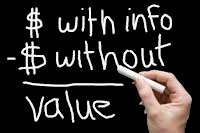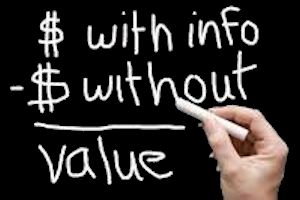Knowing how much your data, experience, and expertise are worth is critical for making smart decisions around investments in data analysis, subject-matter experts, and experienced employees.How can you calculate that value?
Depending on the exact wording of the question you want answered, you should expect different calculated values of information.Useful questions can be sorted into one of three categories.I call the answers to these questions Strategic Value of Information, Perceived Value of Information, and Value of Clairvoyance.
Strategic Value of Information
Strategic VOI is the change in value that occurs because of a change in strategy due to new information.
Strategic VOI is the answer to a question such as “What is my new strategy worth?”, “If I didn't have this information, what would it have cost me?”, or “How much value did I gain by getting this information now?”To answer these questions, you need to compute the value of your ‘situation’ with both your original strategy and your improved strategy and note the difference.(Note that your situation may be the value of your project, company, or any other thing you are valuing.To calculate the value of any type of information, you’ll need to be able to calculate the value of things in general.)
Since decisions are the drivers of value in an organization, Strategic VOI tells us how much additional data, expertise, or experience are worth or how much improvements to strategies, decision models, business intelligence, or new business process have added.
Perceived Value of Information
Perceived VOI is the difference in value calculated with new information versus old information.
Perceived VOI is the answer to the question, “How much did this information change the value of my situation?”For example, you may learn that your engineering team is ahead of schedule or that your products are unexpectedly flying off the shelves.This new information may increase the company’s value and probably stock price as well.Perceived VOI differs from Strategic VOI because we didn’t assume any changes to strategy.That is, there can be a change in value to a company without the company doing anything different, while Strategic VOI is always zero if there is no change in decision.Perceived VOI is the only one of the three types of VOI that can be negative.
Value of Clairvoyance
Value of Clairvoyance is the value of knowing particular information prior to making a decision.
The Value of Clairvoyance is the answer to the question, “How much would it be worth to know that information now, before we make our decision and act, instead of later?”In this case, the information you would like to know could reveal one of two or more possibilities.If the revealed information could potentially change your actions, then knowing it before your decision would have value.You can calculate that value by valuing your original situation versus the situation in which the information will be revealed to you ahead of time.(Note that calculating the Value of Clairvoyance is a shortcut to what you really want to know — should you gather information or not.Value of Clairvoyance can’t guarantee that you'll make the right choice to gather information or not.To make the right decisions, you can explicitly model the decision to gather information as part of a more formal decision model.Value of Clairvoyance is the definition of VOI used in the field of Decision Analysis.For more on VOI in DA, see Wikipedia: Value of Information.
Example: Flipping a Bent (and Sticky) Coin
To see how to calculate the value of these three types of information, we’ll use an example of flipping a bent coin, which is a typical example used to introduce new probability-related ideas.Suppose you and I discover a coin lying on the ground that is obviously bent.I offer you a dollar if you are able to flip the coin and guess whether it lands as heads or tails.You believe that the coin will land on heads with a 60% probability.Having experience calculating expected value, you figure that the expected value of this opportunity is 60 cents.Now suppose that upon closer inspection, you notice that the coin is sticky on the tails side.Suppose this new information changes your probability of heads from 60% all the way down to 30%.(Note that to keep this example simple, I used a small amount of money and am not worrying about how such a small amount of unexpected money may affect your life.Counter to traditional Decision Analysis, I am also not a fan of muddying valuation by including some sort of utility function as a rough estimate of a more complete and accurate model, even with personal decisions.)
Strategic VOI Question
How much value did you gain by learning about the stickiness of the coin before you chose heads or tails?
With the new information about the stickiness, you will now choose tails and have an expected value of 70 cents.You otherwise would have chosen heads and only had an expected value of 30 cents.Knowing about the stickiness is therefore worth 40 cents.
Perceived VOI Question
How much did the stickiness change the value of the opportunity?
You began with a value of 60 cents and ended with a value of 70 cents, so the difference is 10 cents.
Value of Clairvoyance Question
How much would it be worth to know whether the coin will land heads or tails before you flip?
If you know whether the coin will land as heads or tails in advance, then you are guaranteed to get a dollar.The difference between that dollar and the expected value of 70 cents you have if you have to guess is 30 cents.
Value of VOI
The three types of VOI calculate the value of certain types of information, but knowing the value of information also has value.When you want to understand how much impact your current information is having on your actions, you should calculate the Strategic VOI.This knowledge may help you make smart decisions moving forward about the investments you make into your business intelligence.Knowing the Perceived VOI helps you understand the value of things and the effects of various types of information on valuation.This knowledge may also help your judgment and business acumen moving forward, better knowing the value of things and deeply understanding what drives business value.Knowing the Value of Clairvoyance is a shortcut into getting an idea of whether it’s worth the effort to gather more information.Since VOI is simply information, you can also calculate the VOI of VOI, the VOI of VOI of VOI, or as far as you want to take it.




